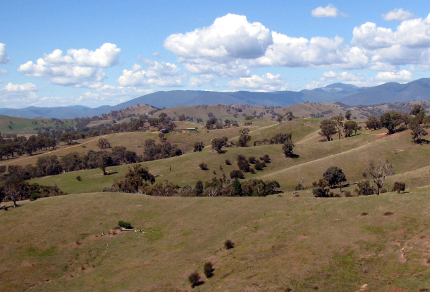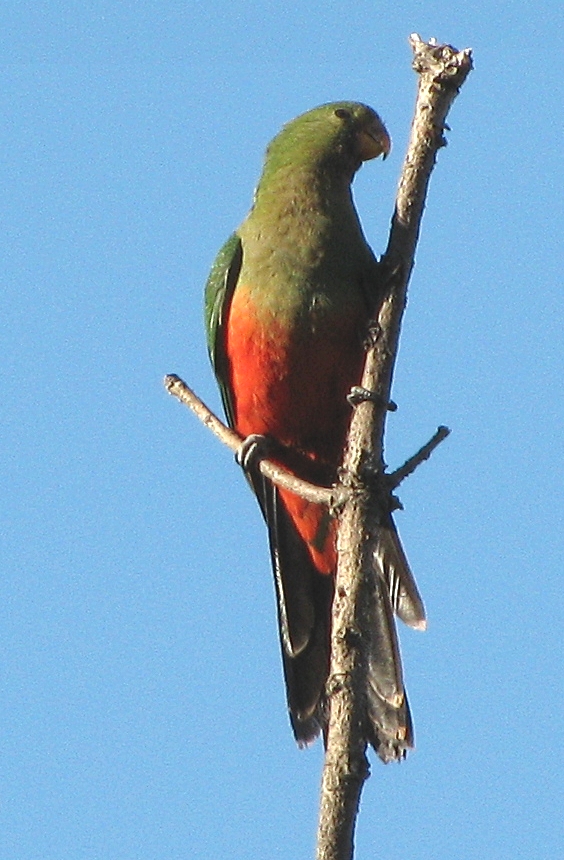
Female Australian King Parrot (© Vilis Nams)
I crept out of bed at 6 a.m. to the sound of kookaburras’ wild laughter, and then back into bed, since darkness had not yet given up its hold on Tallangatta. An hour later, I strolled the streets near the motor inn with binoculars in hand, spotting a pair of magpies and flock of starlings on overhead wires, as well as a tree resounding with the squawks of at least a dozen grey and pink galahs and a female Australian king parrot. The galahs resembled soft-hued, elongated blossoms attached to branches, whereas the king parrot was a beacon of brilliant red and green.
Later, Vilis joined me, and we strolled the streets of Tallangatta. Vilis photographed the lush blossoms of a pink-flowering Melaleuca shrub in which a black and white willie wagtail flitted from branch to branch in bursts of twitching activity. We also observed a restless flycatcher – another evening-suited flycatcher like the willie wagtail, but witha white throat washed with buff – perched atop a high shrub in a Tallangattan’s front yard, and lovely crimson rosellas – slim red and deep blue parrots – foraging in the grass beside a house that looked too modest to harbour such beauty in its yard.
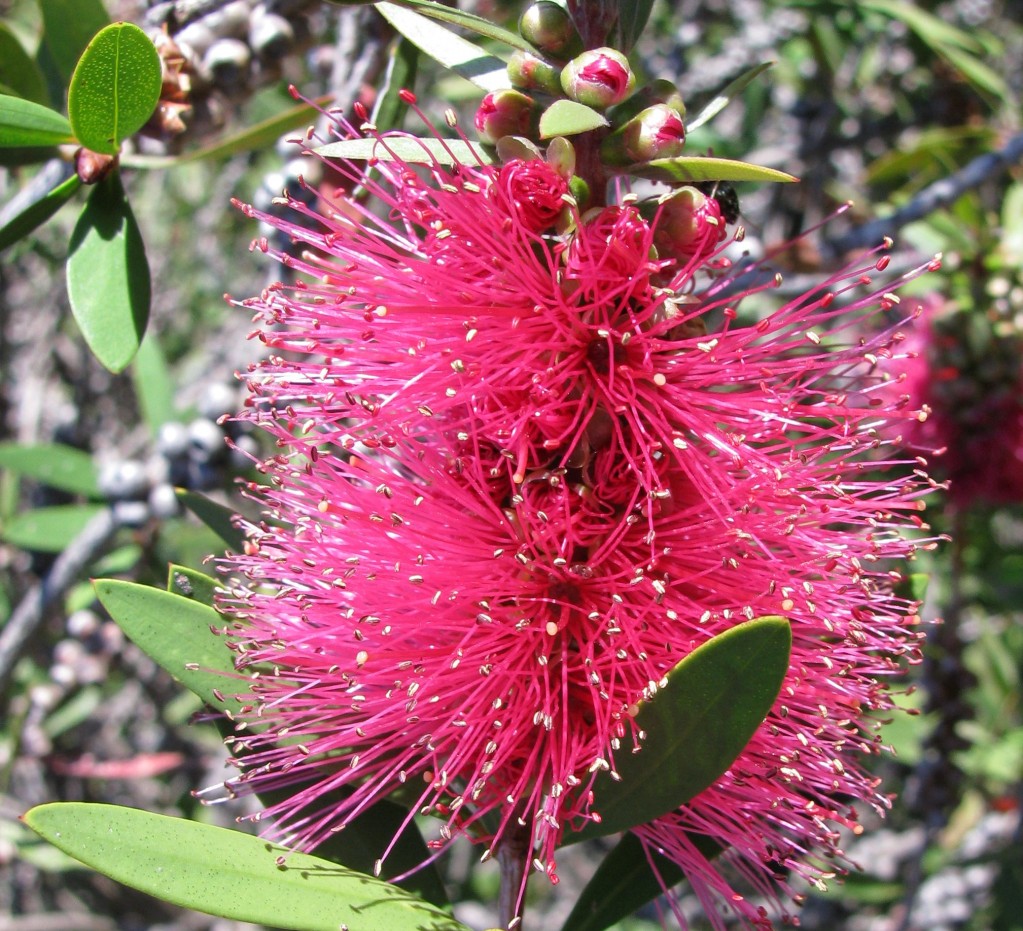
Melaleuca Shrub Blossoms (© Vilis Nams)
Afterward, we ate a late breakfast at the patio table outside our motel room, chatted with two keen female bushwalkers who encouraged us to visit Western Australia – “The plant life is just brilliant!” – and finally drove away from Tallangatta in mid-morning. Following Glenda Bowran’s suggested route, we headed west to Tangambalanga and Yackandandah, traveling between ranges of grazed hills and past signs advertising watermelons and apples for sale, plus a strawberry winery and lavender farm. Dusty-looking gums shaded the narrow pavement, causing Vilis to remark, “Just looking at trees like that makes you thirsty.”
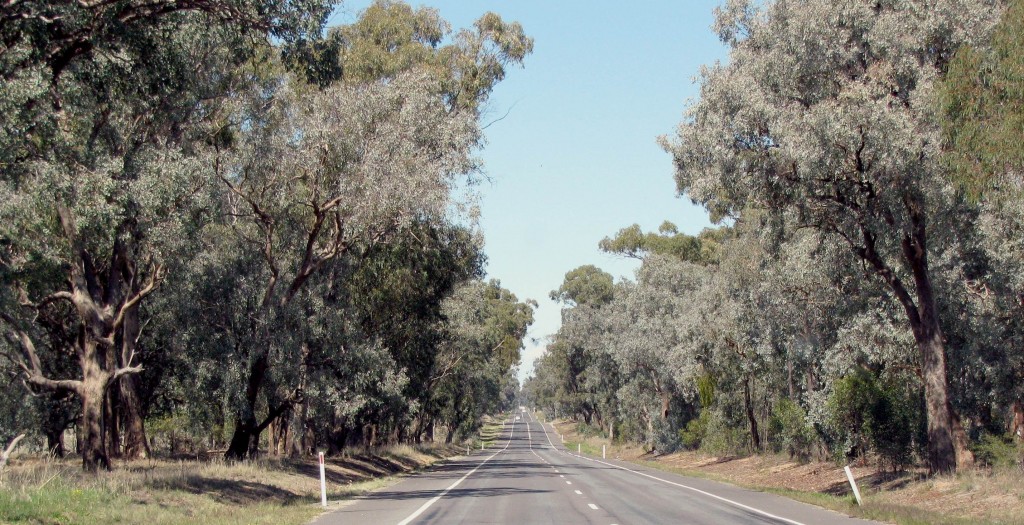
Roadside Eucalypts (© Magi Nams)
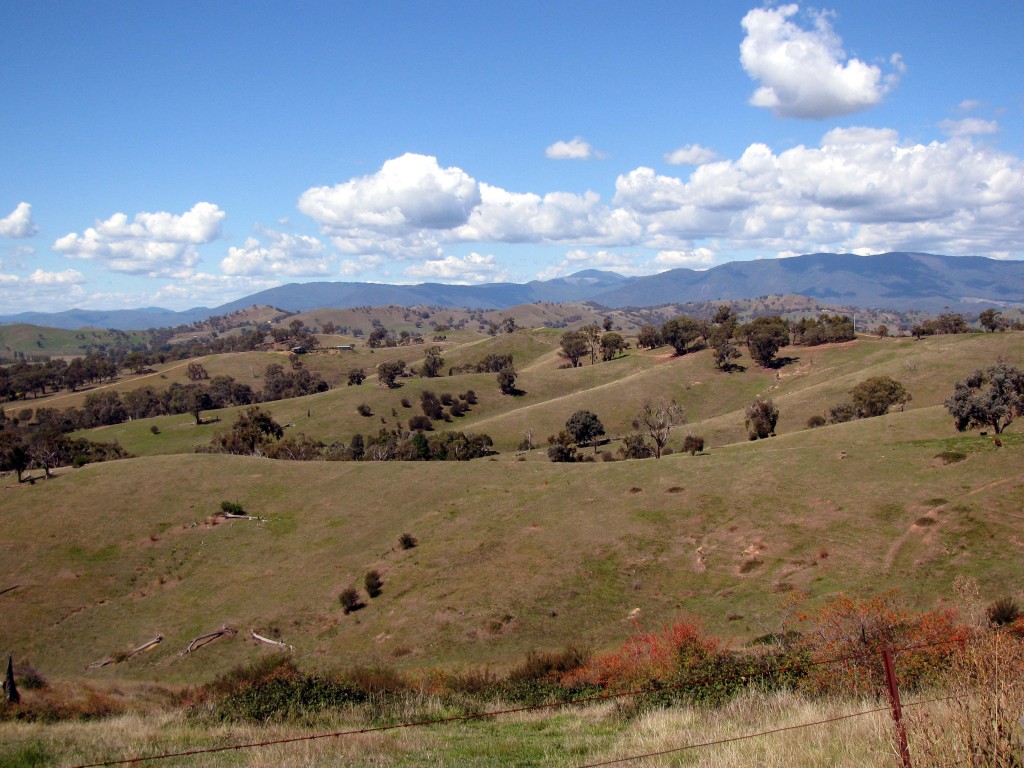
Grazing Country near Beechworth, Victoria (© Magi Nams)
In Beechworth – a tourist hotspot from the amount of activity we observed on a Sunday morning – we paused to visit Beechworth Bakery, which advertises itself as Australia’s greatest bakery. It certainly may have been Australia’s busiest bakery. While Vilis waited a good 15 minutes to order and receive a $4 cup of coffee, I bought a couple of bee stings – 6” diameter light cakes sliced like a bun, filled with custard, and topped with toasted almonds and powdered sugar. Intended to be a late morning snack, the bee stings were so filling that Vilis and I didn’t eat again until supper.
West of Beechworth, the country leveled off into the monotonous grazing land we had driven through for hours yesterday. As per Glenda’s instructions, we took the Hume Freeway from Wangaratta to Benalla to speed through that area, and then turned southward into more rolling hills touched with scattered gums and pockets of forest.
At Buxton, blackened trees on each side of the B360 provided stark evidence of the bushfires that scorched their way through this part of Victoria last year. I had found Marysville – that town so devastated on Black Saturday in 2009 – on the map yesterday, and as we drew closer to the turnoff that would lead us to it, observed the entire face of a craggy peak black and grey with burnt trees, and the grey sticks of scorched trees sticking up like coarse hairs from hilltops. With a sort of dread-infused awe, I recalled an ABC memorial documentary that mentioned the shocking speed at which that catastrophic firestorm had flashed across the landscape – 25 kilometres in 4 minutes. (For more information about Black Saturday, see January 11 blog posting; http://maginams.ca/2010/01/11/.)
“Do you want to go to Marysville?” Vilis asked, and although yesterday I would have said no, today, I said yes. I suppose I wanted to pay homage to it, to offer a silent prayer for a community that had suffered so much. I felt a profound sorrow as we drove through the small town surrounded by hillsides covered with scorched trees. The street trees and some of the town’s buildings and signs bore, evidence of the devastating fire, but hope was visible in a big sign printed with the words ‘Rebuilding Marysville,’ and in the frames of new houses being built to replace those lost to the flames.
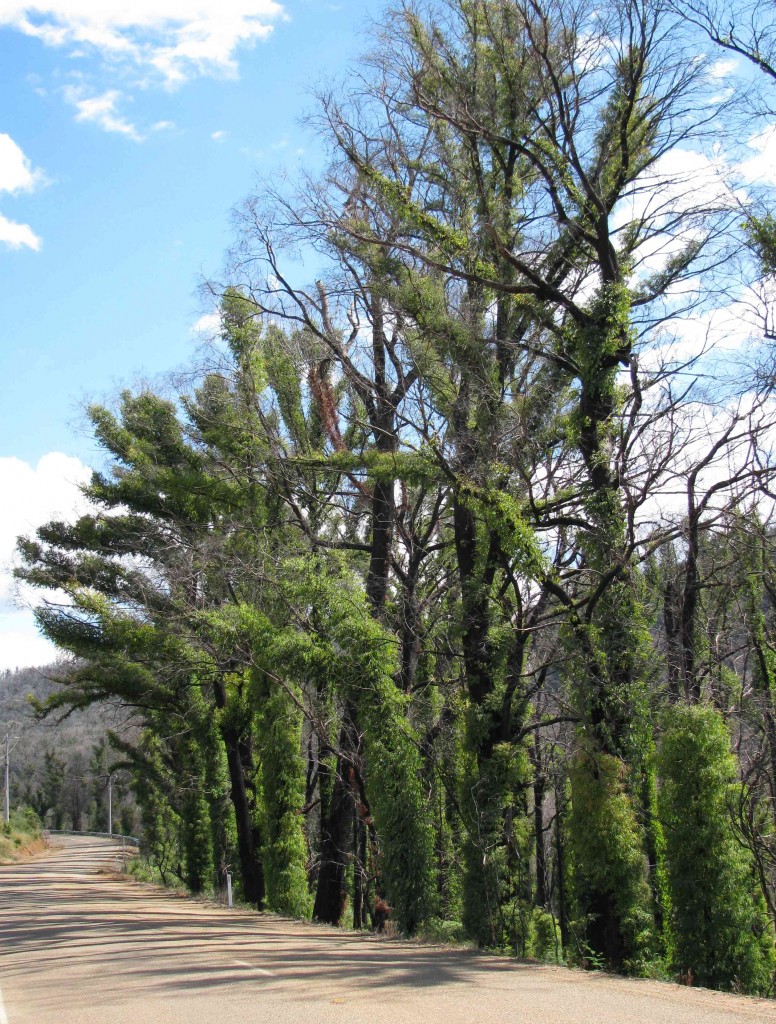
Eucalypts Regenerating after Black Saturday Bushfire (© Vilis Nams)
For the eucalypts in the surrounding hills, the fire brought new life, not death. After leaving Marysville, Vilis and I drove through kilometre after kilometre of blackened forest with trees sprouting astonishingly thick and rich new growth. Of the more than 700 species of gum trees in Australia,1 all but a dozen or so possess lignotubers, which are buds that can sprout right through the bark of roots, trunks, and branches.2 The lush growth we observed was likely the result of lignotubers that had been stimulated into growth by the fire.
Linking up with B360 again, we continued southward into Yarra Ranges National Park, where the Black Spur section of the highway curved and twisted its way along switchbacks tracing the slopes of a valley crowded by peaks thickly forested with mountain ash – gloriously tall, straight eucalypts that towered above the road – and fringed with tree ferns that arced green fronds over the pavement.
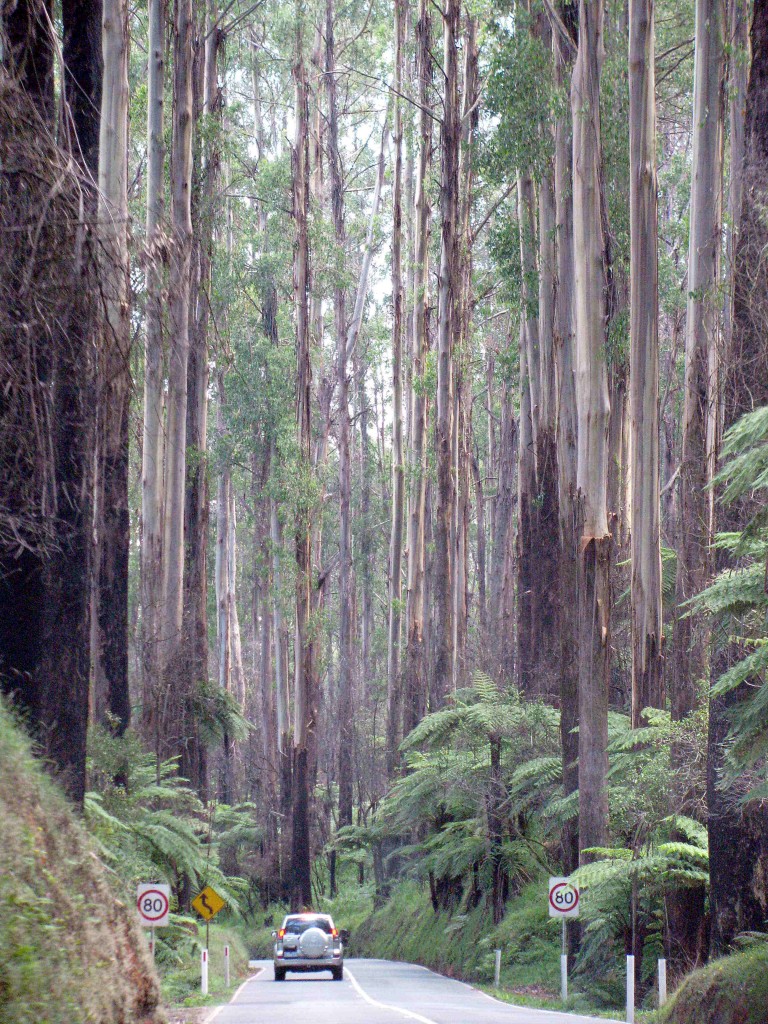
Mountain Ash Forest, Yarra Ranges National Park, Victoria (© Magi Nams)
Traditional homeland of the Wurundjeri tribe, the park is a tract of nearly pristine forest that serves as a water catchment for the city of Melbourne. The section through which we drove had obviously escaped the Black Saturday fires, which burned through almost 40% of the park.
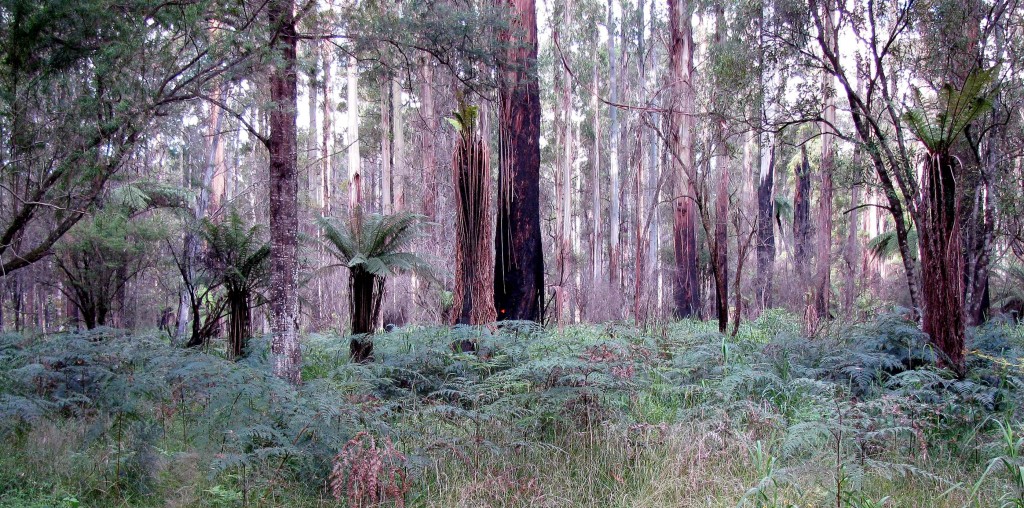
Forest Layers in Yarra Ranges National Park (© Vilis Nams)
At the Fernshaw picnic site, we hiked into the forest, noting its three distinct layers of vegetation – a groundcover of lush, vivid green herbs, grasses and ferns, an understory of tree ferns and shrubs growing to 7 or 8 metres, and an overstory of mountain ash soaring to 80 or 90 metres. I wondered at the height of the trees, which was all it took for Vilis to roughly estimate the height of a large, solitary specimen by utilizing the Pythagorean theorem. He positioned himself at a distance from the tree, raised his arm until I estimated that it represented a 45° angle from the vertical, and then paced the distance to the tree. His estimate of the tree’s height was 92 metres, which translates to 301 feet.
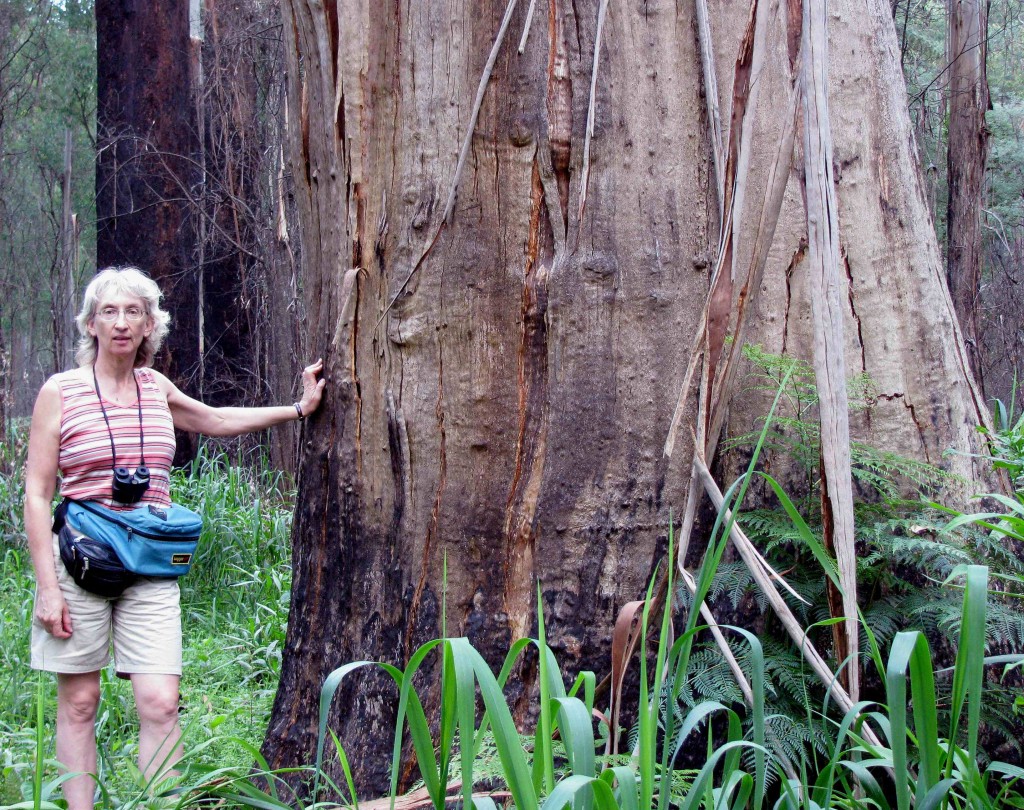
I’m standing beside a Mountain Ash Tree, Yarra Ranges National Park (© Vilis Nams)
Ragged strips of bark shed by the ashes snagged our feet as we walked, and the sounds of vehicles faded as we made our way farther into the open, spacious forest. Surprisingly, there we no mosquitoes, and the track, which an interpretive sign in the picnic area had informed us led to higher elevations that received snow in winter, meandered among the forest giants and beneath tree fern umbrellas. Unfortunately, we ran out of time to explore more, and so returned to the picnic area and the twisting Black Spur that was obviously a favourite with bikers, based on the number of road signs showing skidding motorbikes on slippery sections.
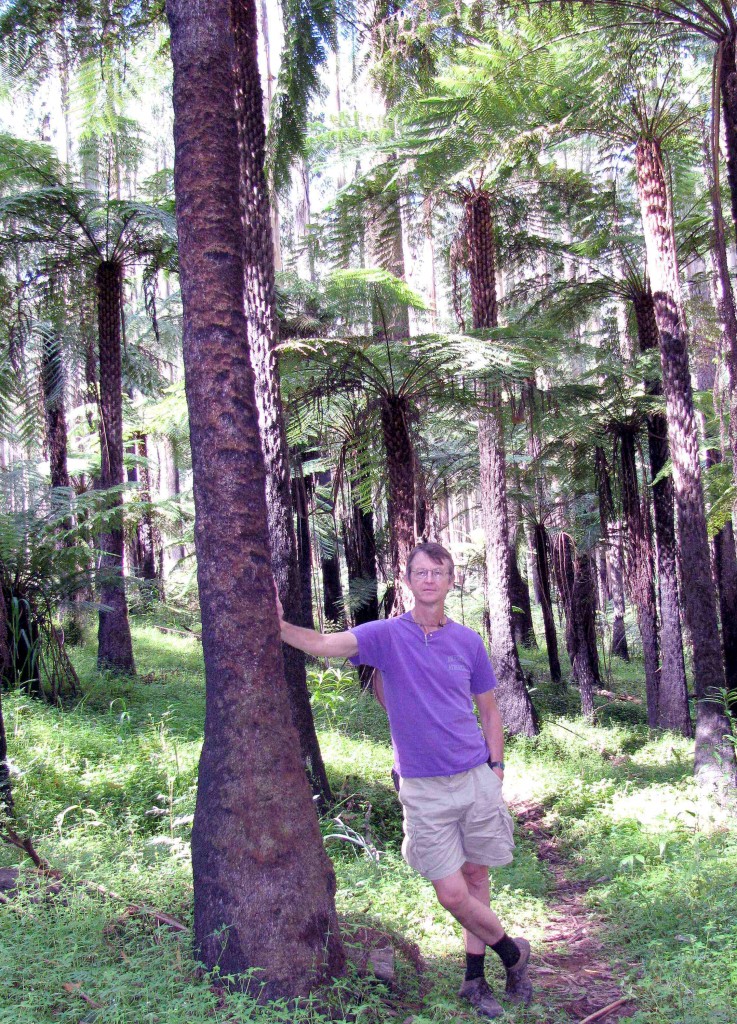
Vilis and Tree Ferns in Mountain Ash Forest, Yarra Ranges National Park (© Magi Nams)
A detour in Healesville sent us north to Toolangi and a section of road leading to Kinglake that was, without a doubt, the twistiest 10 kilometres we had ever driven, peppered with speed detectors and Slow Down signs, as well as a whole lot more of those warning signs for bikers. Vilis gobbled it up, easing the Lancer around curves so tight that our bodies leaned into the fire-scorched mountainside as though to meld with it.
Dusk fell as we returned the rental car to the airport and caught a taxi into the city centre. The skyscrapers that had seemed like a mirage from our hotel room yesterday morning now loomed above us like a concrete forest lit by uncountable lights. This was Melbourne, capital of the state of Victoria and, from what I’d read, one of Australia’s cultural hotspots. For the next three days, it would be mine to explore.
Reference:
1. Ashley Hay. Gum: the story of eucalypts and their champions. 2002. Duffy & Snellgrove, Sydney, p. 2; 2. Ibid, p. 211.

